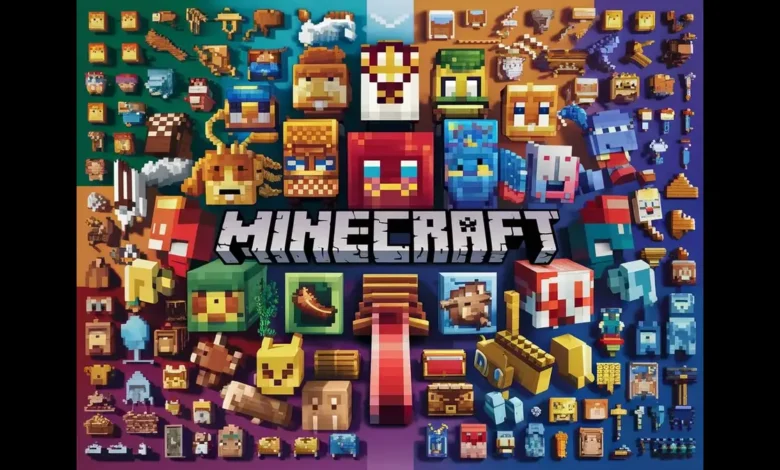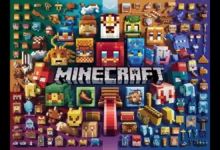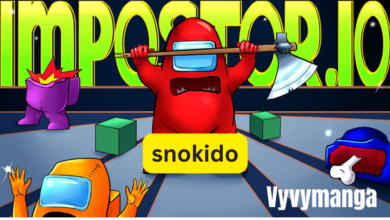The Evolution of Minecraft (2009) game icons banners: A Look Back at 2009 Designs

Introduction to minecraft (2009) game icons banners
Since its minecraft (2009) game icons banners has taken the gaming world by storm. With its blocky aesthetics and limitless creativity, it quickly became a favourite among players of all ages. One of the most fascinating aspects of minecraft (2009) game icons banners is how it has evolved, especially when we look at game icons and banners.
These visual elements represent the game and capture moments in its history. As we dive into this nostalgic journey, we’ll explore how those early designs have changed and what they mean for players and creators today. Join us as we unravel the story behind minecraft (2009) game icons banners icon banners—a tale filled with innovation, community influence, and nostalgia!
History of game icons and banners in minecraft (2009) game icons banners
The history of game icons and minecraft (2009) game icons banners begins with its early days. Released in 2009, the game featured simple graphics that embodied a blocky charm. The icons were straightforward yet memorable.

As players immersed themselves in this pixelated world, they began associating specific designs with their adventures. The iconic grass block became synonymous with minecraft (2009) game icons banners itself. Banners soon followed, allowing players to express creativity beyond mere gameplay.
In those formative years, community contributions flourished. Fan art and mods led to diverse interpretations of existing designs. This grassroots movement inspired Mojang to embrace player-generated content more actively.
Over time, banners evolved from basic shapes into intricate patterns reflecting unique identities within the game’s universe. Each update introduced fresh elements while honouring the original aesthetic that fans cherished deeply.
A comparison of minecraft (2009) game icons banners designs to current designs
The contrast between 2009 designs and today’s icons is striking. Back in the early days, minecraft (2009) game icons banners were simple yet charming. They captured the essence of blocky graphics with a pixelated style that spoke volumes about its indie roots.
Fast forward to now, and we see a shift towards more polished aesthetics. Current banners feature vibrant colours, intricate details, and enhanced textures. The Evolution reflects not just technological advancements but also an expanding player base.
While today’s designs are visually appealing, they sometimes lack the nostalgic charm of their predecessors. There’s something special about those early icons; they evoke memories of exploration in a newly discovered world.
This blend of simplicity and creativity from 2009 continues to resonate within the community. It reminds players where it all began while allowing room for growth and innovation in design philosophy today.
How the community has influenced the Evolution of game icons and banners
The minecraft (2009) game icons banners community has always played a pivotal role in shaping the game’s identity. From mods to custom skins, players have pushed creative boundaries that developers often embrace.
Fan-made content frequently inspires official designs. For instance, iconic banners and game icons feature player-created themes and styles, reflecting collective creativity. This collaboration fosters a dynamic feedback loop between developers and gamers.
Online forums and social media platforms serve as melting pots for ideas. Discussions about aesthetics spark innovation, leading to unique interpretations of classic elements.
As players share their visions, trends emerge that catch on quickly within the community. These trends often find their way into game updates or promotional materials.
This rich tapestry of user-generated content transforms how minecraft (2009) game icons banners visual language evolves, ensuring it stays relevant in an ever-changing gaming landscape.
The impact of technology advancements on design changes
Technological advancements have dramatically changed the landscape of video game design. When launched in 2009, its graphics were basic but charming, encapsulating a blocky aesthetic that defined its early appeal.
Designers began experimenting with more sophisticated visuals as hardware improved and software capabilities expanded. This Evolution allowed for richer textures and dynamic lighting effects, enhancing gameplay experiences.
Moreover, the rise of high-definition screens has transformed how players perceive game icons and banners. Clearer resolutions mean that every pixel matters, leading developers to create visually stunning designs that resonate with modern audiences.
Tools like vector graphic software have also made it easier for artists to craft intricate designs. Thanks to user-friendly platforms designed for modding and customization, the community can now easily create custom content. These developments shape what we see today in minecraft (2009) game icons banners evolving visual identity.
Nostalgia and the importance of preserving old designs
Nostalgia plays a decisive role in the gaming community. For many players, minecraft (2009) game icons banners is more than just a game; it’s a cherished memory from their childhood. The designs of 2009 evoke feelings of joy and simplicity.
Old game icons and banners tell stories of early adventures. They remind us of uncharted territories explored with friends, late-night builds, or first encounters with Creepers. Each pixelated detail holds value.
Preserving these original designs is vital for future generations. It allows newcomers to appreciate how far the game has come while connecting them to its roots. Old aesthetics carry history and context that enrich the overall experience.
The charm of those early graphics resonates today. Even as modern updates arrive, there’s something special about looking back at where it all began—an integral part of what makes Minecraft unique within gaming culture.
Conclusion: The future of minecraft (2009) game icons banners designs and their significance in gaming culture
As we look ahead, the future of minecraft (2009) game icons banners 1designs promises to be as dynamic and engaging as its past. The Evolution of game icons and banners reflects the game’s growth and the passionate community surrounding it. Players continue to express their creativity through modding and custom skins, pushing developers to innovate further.
With advancements in technology, such as higher-resolution graphics and sophisticated design tools, we can expect stunning visuals that enhance gameplay experiences. Yet amidst all these changes, fans strongly desire to preserve elements from earlier versions, like those iconic 2009 designs.
These old aesthetics are sentimental for many players who grew up with them. They are snapshots of a simpler time within an ever-expanding universe. As Minecraft continues to evolve, new players and veterans must appreciate this journey.
The significance of these designs lies not just in their visual appeal but also in their role within gaming culture itself. Each banner or icon tells a story that connects millions across generations and serves as a reminder of where this beloved game began. This connection ensures that no matter how far Minecraft travels into the future, its roots will always remain firmly planted in the heart of every player who has picked up a pickaxe or built a blocky castle.


